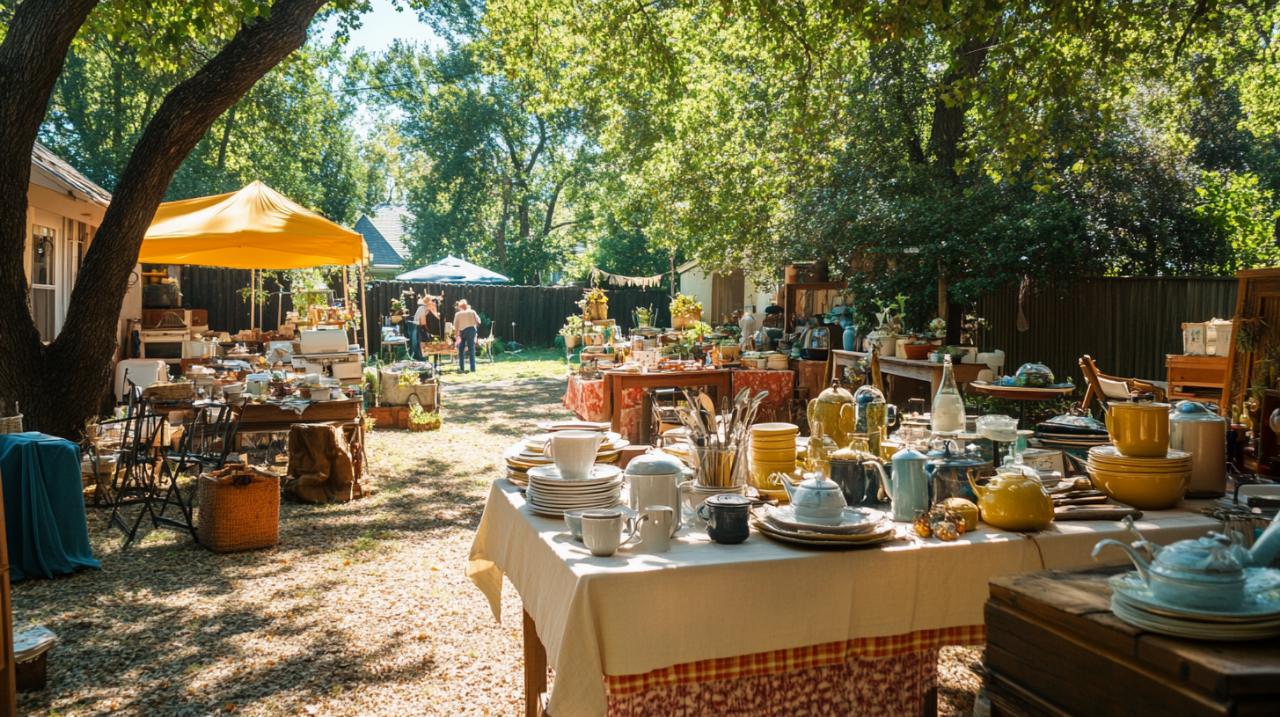Transforming your home into a temporary marketplace offers a brilliant opportunity to declutter, generate a bit of extra pocket money, and embrace responsible consumerism. Whether you refer to it as a yard sale, car boot sale, or jumble sale, the concept remains the same: selling pre-loved goods directly to your local community. Success in these ventures depends heavily on meticulous planning, strategic pricing, and effective advertising. With the right approach, you can attract bargain hunters, clear out unwanted items, and create a lively, welcoming atmosphere that benefits everyone involved.
Planning and Preparation for Your Garage Sale
Decluttering Your Home and Selecting Items to Sell
Before you can organize a successful garage sale, you must undertake a thorough decluttering session. Walk through each room of your home and identify items that no longer serve a purpose or bring joy. Focus on good quality belongings that others might find useful, such as like-new clothes and accessories, purses, sports equipment, household items, hardcover books, power tools, unbroken toys, and furniture. Creating a detailed inventory list helps you keep track of what you plan to sell and assists with pricing decisions later on. Sort your belongings into clear categories: items to sell, items to donate or discard, and items to keep. This methodical approach ensures that only the most suitable pieces make it to your sale, maximising your chances of generating income while responsibly managing what remains.
Setting the Perfect Date and Time for Maximum Footfall
Choosing the right date and time significantly impacts the turnout at your garage sale. Weekends, particularly Saturdays, tend to be the busiest days as most people are free from work commitments. The period between May and September is generally ideal, as warmer weather encourages more foot traffic. Aim to start early in the morning, around eight o’clock, and run the sale until mid-afternoon, roughly three o’clock. This schedule allows early birds to browse first thing and gives you ample time to engage with a steady stream of shoppers throughout the day. Before finalising your plans, check with your local council to see if you need any permits or licences, as some areas require formal approval for such events. Setting a clear goal for the money you hope to make can also help you stay motivated and focused during the preparation process.
Marketing Your Garage Sale to the Local Community
Creating eye-catching posters and signage
Effective advertising is crucial to drawing a crowd to your garage sale. Start by designing bright, readable posters that catch the eye from a distance. Include essential information such as your address, the date, the time, and a few key items that might entice potential buyers. Use bold colours and large fonts to ensure your signs are visible to passing traffic. Place these posters strategically around your neighbourhood, particularly at busy junctions and along main roads, with directional arrows guiding people to your location. Putting up signs the night before the sale can help build anticipation and give people time to plan their visit. Remember to take down all your signage promptly after the event to keep the area tidy and maintain good relations with your neighbours.
Leveraging Social Media to Spread the Word
In addition to traditional advertising methods, social media offers a powerful platform to promote your garage sale. Post detailed announcements on local community groups, neighbourhood pages, and your personal profiles. Include a comprehensive list of items for sale, directions with landmarks, and any special promotions you plan to offer, such as bundle deals or discounts for multiple purchases. Online marketplaces and classified sites can also be useful for reaching a wider audience. Encourage friends and family to share your posts to extend your reach even further. Updating your online ads regularly and responding promptly to queries helps build interest and ensures potential buyers have all the information they need to visit your sale. This dual approach of physical signage and digital promotion maximises your chances of attracting a diverse range of shoppers.
Pricing strategies and negotiation tips

Establishing fair and attractive prices
Pricing your items correctly is a delicate balance between making a profit and ensuring your goods are attractive to buyers. Generally, second-hand items sell for between ten and thirty per cent of their original retail price, depending on their condition, brand, and current demand. Conduct some research by checking what similar items are selling for at other car boot sales, charity shops, and online platforms. For example, books might fetch one to three pounds each, while adult clothing could go for three to five pounds per item. Small kitchen appliances might be priced between five and fifteen pounds, and furniture can often be sold at seventy to eighty per cent off the retail value. Use clear pricing tags on everything to build trust with customers and speed up the transaction process. Consider using coloured stickers to indicate different price ranges, making it easier for shoppers to spot bargains at a glance.
Embracing the Art of Bartering with Buyers
Haggling is an integral part of the car boot sale culture, and being open to negotiation can help you shift more stock. Build some wiggle room into your initial prices so you can comfortably offer small discounts without feeling shortchanged. Be prepared to adjust your prices as the day progresses, particularly for items you are keen to clear. However, know your limits and avoid wasting time with low ballers who make unrealistic offers. Politely decline offers that are far below your acceptable threshold and focus on engaging with serious buyers. Encourage repeat purchases by offering deals on additional items, such as buy one get one free or discounts for buying in bulk. Pointing out the value and quality of your items can also justify your prices and help you secure a fair deal. Remember, the goal is to create a win-win situation where both you and the buyer feel satisfied with the transaction.
Setting up your garage sale for success
Arranging items to attract bargain hunters
On the day of your garage sale, presentation is everything. Set up your market in a bright, spacious area with easy access for customers. Arrange your items on tables, shelves, or blankets to create an organised, shop-like atmosphere. Group similar items together to make it easier for shoppers to find what they are looking for. For instance, place all clothing on racks, display books and media on one table, and arrange household goods on another. Position high-value or eye-catching items near the street to draw people in. Ensure there are clear pathways so customers can move around comfortably without feeling cramped. Having a free box for low-value items can also attract browsers and create goodwill. Take the time to keep your display neat and tidy throughout the day, as a well-maintained setup signals professionalism and encourages more sales.
Preparing Change and Carrier Bags for Transactions
Before your sale begins, ensure you have adequate change on hand to facilitate smooth transactions. Aim for at least one hundred pounds in small denominations, including coins and five-pound notes. Keep your cash box secure and out of sight to prevent theft. While cash is the most common payment method at garage sales, consider offering digital payment options such as Venmo or PayPal to accommodate a wider range of customers. Have plenty of plastic bags or reusable carriers available for buyers to transport their purchases. A designated checkout table with a calculator can help you manage multiple transactions efficiently. If you are selling electronics, having an outlet nearby to test items can reassure buyers of their functionality and increase your chances of making a sale. Being well-prepared for the practical aspects of your sale ensures a positive experience for both you and your customers.
Managing the Day of Your Garage Sale
Engaging with Customers and Handling Negotiations
On the day of your sale, your demeanour and customer service skills play a vital role in your success. Greet each potential buyer with a warm smile and a friendly attitude. Be knowledgeable about your items and ready to answer questions or provide additional details. Building rapport with shoppers can lead to more sales and encourage them to return or recommend your sale to others. When handling negotiations, remain calm and polite, even if faced with challenging buyers. Be open to reasonable offers but stand firm on your minimum acceptable prices. Count change back carefully during each transaction to avoid mistakes and build trust. Having friends or family members assist you can help manage multiple customers at once and keep an eye on your stock. Engaging positively with your community throughout the day enhances the overall experience and increases the likelihood of a successful sale.
Creating a Welcoming Atmosphere for Shoppers
A pleasant, inviting atmosphere can set your garage sale apart from others. Consider offering complimentary refreshments such as tea, coffee, or biscuits to make visitors feel welcome. Playing soft background music can add to the ambience and encourage shoppers to linger longer. Ensure your space is well-lit, especially if you are selling items inside a garage or shed. Keep the area clean and organised, regularly tidying up as the day progresses. If the weather is unpredictable, have a plan in place to protect your items from rain or excessive sun. Creating a comfortable, enjoyable environment not only boosts sales but also fosters a sense of community and goodwill. Shoppers are more likely to return to future events if they associate your sale with a positive experience.
Dealing with unsold items after your garage sale
Donating leftover goods to charity shops
Once your garage sale has concluded, you will inevitably have some items that did not sell. Rather than allowing these goods to clutter your home again, consider donating them to local charity shops. Many organisations accept a wide range of items, from clothing and books to household goods and furniture. Donating unsold stock not only supports a good cause but also ensures that your efforts contribute to sustainable shopping practices. It is a responsible way to manage leftovers and can provide you with a sense of accomplishment knowing that your pre-loved goods will benefit others in need. Before making a donation, check with the charity about their specific requirements and arrange a convenient drop-off time.
Taking remaining items to your local recycling centre
For items that are not suitable for donation, such as broken or heavily worn goods, taking them to your local recycling centre is the most responsible option. Many recycling centres accept a variety of materials, including electronics, textiles, and household waste, ensuring that these items are disposed of in an environmentally friendly manner. This step helps reduce landfill waste and supports broader efforts towards junk clearance and rubbish removal. After your sale, take a moment to reflect on what worked well and what could be improved for next time. Analysing which items were popular, what pricing strategies were effective, and whether your advertising efforts paid off can help you refine your approach for future events. Regular garage sales can become a valuable source of additional income, strengthen community ties, and promote more sustainable consumer habits.



